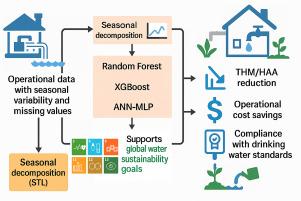Hybrid machine learning model for disinfectant dosing in small-scale water treatment under data scarcity
IF 6.7
2区 工程技术
Q1 ENGINEERING, CHEMICAL
引用次数: 0
Abstract
Disinfection by-products, including trihalomethanes and haloacetic acids, pose persistent risks to human health and aquatic ecosystems, particularly in small-scale water treatment plants characterized by limited automation and incomplete monitoring records. This study proposes a hybrid model that integrates extreme gradient enhancement with seasonal trend decomposition, allowing incomplete time series to be partitioned into trend and seasonal components, thereby improving prediction stability and improving interpretability of variable influence. The main contribution is a method that explicitly addresses seasonal variability and data scarcity while preserving predictive accuracy under infrastructure constraints, achieving and RMSE values between 0.15 and 0.30. The model was validated in a real decentralized system, where it exhibited high performance even with data missing up to 30%, producing monthly reductions of approximately 450 g of trihalomethanes and 800 g of haloacetic acids, along with lower chlorine and fluoride consumption. By integrating technical, environmental, and economic dimensions, including measurable financial returns with a positive annual ROI and a short payback period, the approach provides a replicable solution for dosing control in data-limited contexts, aligned with the Sustainable Development Goal 6 of the United Nations and the advancement of responsible digital strategies in the water sector.

数据稀缺条件下小型水处理中消毒剂投加的混合机器学习模型
消毒副产物,包括三卤甲烷和卤乙酸,对人类健康和水生生态系统构成持续风险,特别是在自动化程度有限和监测记录不完整的小型水处理厂。本研究提出了一种结合极端梯度增强和季节趋势分解的混合模型,将不完整的时间序列划分为趋势分量和季节分量,从而提高了预测的稳定性,提高了变量影响的可解释性。主要贡献是一种明确解决季节变化和数据稀缺性的方法,同时在基础设施约束下保持预测准确性,实现R2≥0.90,RMSE值在0.15和0.30之间。该模型在一个真实的分散系统中进行了验证,即使数据丢失高达30%,该模型也表现出高性能,每月减少约450克三卤甲烷和800克卤乙酸,同时减少氯和氟化物的消耗。通过整合技术、环境和经济维度,包括具有正年度投资回报率和较短投资回收期的可衡量财务回报,该方法为数据有限背景下的剂量控制提供了可复制的解决方案,与联合国可持续发展目标6和水部门负责任的数字战略的推进相一致。
本文章由计算机程序翻译,如有差异,请以英文原文为准。
求助全文
约1分钟内获得全文
求助全文
来源期刊

Journal of water process engineering
Biochemistry, Genetics and Molecular Biology-Biotechnology
CiteScore
10.70
自引率
8.60%
发文量
846
审稿时长
24 days
期刊介绍:
The Journal of Water Process Engineering aims to publish refereed, high-quality research papers with significant novelty and impact in all areas of the engineering of water and wastewater processing . Papers on advanced and novel treatment processes and technologies are particularly welcome. The Journal considers papers in areas such as nanotechnology and biotechnology applications in water, novel oxidation and separation processes, membrane processes (except those for desalination) , catalytic processes for the removal of water contaminants, sustainable processes, water reuse and recycling, water use and wastewater minimization, integrated/hybrid technology, process modeling of water treatment and novel treatment processes. Submissions on the subject of adsorbents, including standard measurements of adsorption kinetics and equilibrium will only be considered if there is a genuine case for novelty and contribution, for example highly novel, sustainable adsorbents and their use: papers on activated carbon-type materials derived from natural matter, or surfactant-modified clays and related minerals, would not fulfil this criterion. The Journal particularly welcomes contributions involving environmentally, economically and socially sustainable technology for water treatment, including those which are energy-efficient, with minimal or no chemical consumption, and capable of water recycling and reuse that minimizes the direct disposal of wastewater to the aquatic environment. Papers that describe novel ideas for solving issues related to water quality and availability are also welcome, as are those that show the transfer of techniques from other disciplines. The Journal will consider papers dealing with processes for various water matrices including drinking water (except desalination), domestic, urban and industrial wastewaters, in addition to their residues. It is expected that the journal will be of particular relevance to chemical and process engineers working in the field. The Journal welcomes Full Text papers, Short Communications, State-of-the-Art Reviews and Letters to Editors and Case Studies
 求助内容:
求助内容: 应助结果提醒方式:
应助结果提醒方式:


